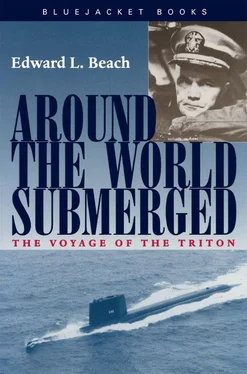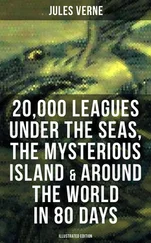The garbage ejector is a large potential hazard to submarines because of the frequency with which it must be used and the fact that the men handling trash and garbage are generally the least experienced on board. It is so vitally important that at least one ejector door be kept closed at all times that these mechanisms may only be operated by a fully qualified auxiliaryman. Maloperation could result in uncontrolled flooding of the ship.
Despite our careful handling of the garbage ejection system, a problem arose; after the garbage was flushed out, the outer door could not be closed. Full sea pressure, consequently, was riding against the breech door of the ejector—a door built to close against sea pressure instead of with it. The situation was highly undesirable. No one knew how much pressure the hinge of the inner door could stand.
Fortunately, my worries were short-lived. About an hour’s work by Chief Engineman Edwin Rauch, Machinist’s Mate First Class Bob Carter, and Engineman Third Class John Boreczky restored the door to normal operation. Tom Thamm, whose responsibility this was, looked a little sheepish when I asked him what had caused the trouble. This day happened to be the day the garbage ejector was supposed to be greased; so much grease had been rammed into its operating mechanism, and under such force, that a pressure lock was created and the gears had jammed.
During this portion of our trip, we began our weekly divine services. These were held every Sunday in the crew’s mess hall, the only suitable compartment in the ship (where forty-six persons could be accommodated at a single sitting). The first turnout was disappointing; possibly the fact that there was no ordained minister of any faith on board reduced the appeal of the service, but we resolved, nevertheless, to keep up the practice whenever Triton happened to be at sea on a Sunday. Will Adams and I discussed the matter at some length, and finally decided that we should not attempt in any way to pressure our shipmates to attend. Despite our own feelings, attendance, we decided, should always remain entirely voluntary.
On any map where the contour of the bottom of the Atlantic Ocean is shown, an elongated shallow area passing through the Azores can be seen; it curves approximately in the center of the ocean as it crosses the equator and heads into the South Atlantic, where it finally disappears. This area is known to oceanographers as the Mid-Atlantic Ridge. The Azores are mountain peaks, where the Mid-Atlantic Ridge projects above the surface of the water, as are St. Peter and St. Paul’s Rocks.
The Mid-Atlantic Ridge, a pressure ridge created as the earth’s mass cooled millions of years ago, has never presented a hazard to mariners. Only the Azores themselves, or certain other islands, are surrounded by water shallow enough to be of any concern. Much of the Ridge, therefore is not even well charted. Deep traveling submarines are not at all like other ships, however, for they require much more depth. This was another reason for our voyage, to make a world-girdling recording of the bottom contour. One of the special devices with which Triton had been fitted during the hectic two weeks before she sailed was for this purpose. Outfitted with many miles of expensive, sensitized paper, the device operated from our fathometer, taking many soundings per minute and recording them graphically so as to show a virtual photograph of the shape of the bottom of the ocean over which we had just passed. It was with justice officially called the “Precision Depth Recorder (PDR).”
As is well known, the ocean is full of mountains, just as is the land, but very few of the ocean’s mountains have ever been mapped. As Triton approached the vicinity of St. Peter and St. Paul’s Rocks, we expected to notice a gradual shoaling of water, and the PDR was carefully watched.
Civil Engineer Gordon E. Wilkes was aboard to monitor the equipment. In addition, in order to obtain immediate value from anything the PDR might detect, a special watch was detailed to observe it. During the early morning of the twenty-third of February, more than twenty-four hours before we should reach St. Peter and St. Paul’s Rocks, sudden and very rapid shoaling was recorded on the PDR. This was immediately brought to the attention of the Officer of the Deck by Jerry Saunders, Radarman Second Class, who at the moment was on PDR watch. We were still quite some distance from where we expected to find the Mid-Atlantic Ridge, and soundings recorded but a few moments earlier indicated a depth of roughly two thousand fathoms.
This “seamount” must have been of extremely solid structure, for it towered over the relatively flat sea bottom to a height of nearly nine thousand feet. Its sides were precipitous and its craggy form, profiled on the PDR, resembled the spires of a medieval cathedral. We slowed to creeping speed as we came up on the mount, for we had to be able to avoid it should it extend to our depth level. Slowly, we crept over the area, recording a minimum sounding of nine hundred and thirty fathoms, and then reversed course and ran over the same track. Criss-crossing, we pinpointed the peak’s location and traced an outline of it from all sides.
It must be admitted that coming as it did without warning, the abrupt decrease in soundings startled me. We could not see ahead, of course, except by sonar, and until we actually had passed over it and determined the minimum distance between the top of the seamount and the surface, there was no way to guess how high the peak might actually reach. Had it reached higher, had we been traveling much deeper than we were, and had we not been keeping the careful watch that we were keeping, we might have struck it in the manner of an aircraft striking a mountain. The results would have been equally calamitous.
As I left the control room, with the peak safely astern and its location carefully logged, I noticed that this particular submerged mountain had already received a name.
Conforming to the tradition that the discoverer of prominent geographical features has the right to name them, Jerry Saunders had neatly inscribed “Saunders Peak” opposite its location on our track chart.
Saunders Peak will present no hazard to submarines until they travel much deeper than they are yet able to do. But, nevertheless, it had not been marked on any chart before this. We had made a new discovery.
The twenty-fourth of February was the day we expected to sight St. Peter and St. Paul’s Rocks. According to navigator Will Adams, we should see the islet dead ahead on the horizon at about noon. Prior to this time we had studied every bit of lore we had on board about the Rocks, but there was very little to be learned. Sailing Directions described it as bare and useless, a one-time guano collecting spot, noting that there had once been a small dock, long since washed away, and that the highest rock had an abandoned lighthouse surmounting it.
We had been totally submerged for over a week, and as bad luck would have it, for the last thirty-six hours the sky had been overcast. It was consequently impossible for Will to get any sights through our new-fangled periscope. At 4:00 A.M. there was not a star in the sky, and at 0830 we went to periscope depth again in hopes of shooting the morning sun. At this time, as we rose through a temperature layer in the water, the sound of foreign propeller beats suddenly came in loud and clear. It was a striking example of how a temperature or salinity difference in the water will block the sonar return of a ship at relatively close range.
Carefully, we conned Triton through the evolutions necessary to come safely to periscope depth, and finally got the fragile periscope tube out of water. Our contact was a motor ship of eight thousand or ten thousand tons, with a white hull, buff stack, nice-looking clipper bow, a large deckhouse, many king posts, and apparently considerable deck machinery. She must also have been fitted to carry passengers—an easy deduction from the size of her deckhouse and the number of portholes evident. But we were much too far away to make out her nationality.
Читать дальше












